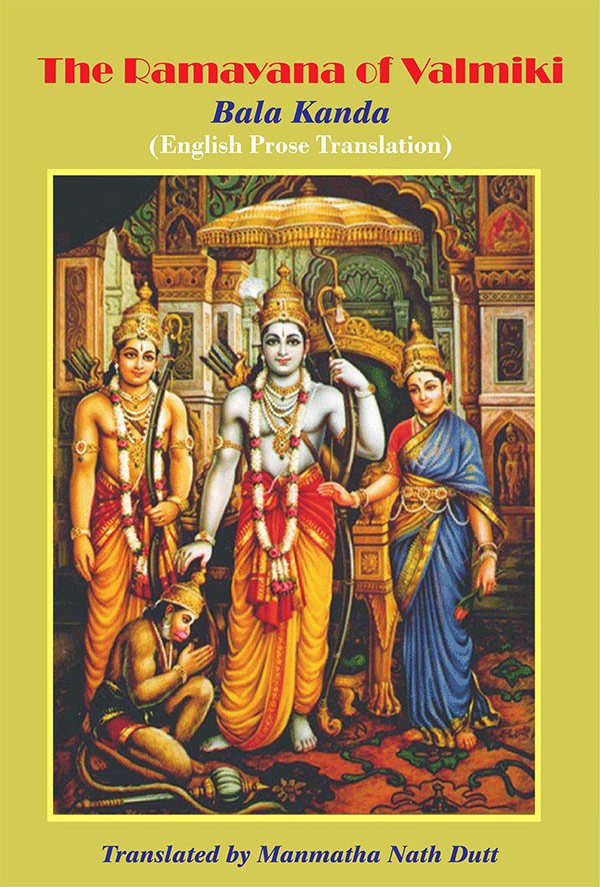Ramayana of Valmiki
by Hari Prasad Shastri | 1952 | 527,382 words | ISBN-10: 9333119590 | ISBN-13: 9789333119597
This page is entitled “the city of vishala and the churning of the ocean” and represents Chapter 45 of the Bala-kanda of the Ramayana (English translation by Hari Prasad Shastri). The Ramayana narrates the legend of Rama and Sita and her abduction by Ravana, the king of Lanka. It contains 24,000 verses divided into seven sections [viz., Bala-kanda].
Chapter 45 - The city of Vishala and the churning of the ocean
[Full title: Vishvamitra begins to relate the story of the city of Vishala and the churning of the ocean, which leads to the combat between the Devas and the Daityas]
Shri Ramacandra and Shri Lakshmana were filled with astonishment on hearing the words of Shri Vishvamitra, and said to him: “O Holy Sage, marvellous indeed is the history of King Sagara and the descent of the Ganges, which you have related to us.”
The night drew on as they had been listening to the story, and Shri Rama and Lakshmana passed the remaining hours meditating on the matter.
The clear day dawned and Shri Rama, having performed his daily devotions, said to Shri Vishvamitra: “The night has passed in listening to this divine narrative, it has slipped away, as if it were a moment. Now let us cross the sacred and merit-giving stream reflecting on its marvellous origin. Knowing you to have come, the other sages have sent a boat in preparation for crossing the holy river.”
Shri Vishvamitra summoned the ferryman and with the princes and sages all were conveyed to the other side. They rested awhile on the opposite bank and entertained the sages in their company. In the distance, they saw the city named Vishala and soon the great Rishi Vishvamitra with the princes reached that place of beauty, which resembled one of Indra’s cities.
Then Rama, full of wisdom, approached the holy sage and humbly made enquiry concerning the city. He said: “O Great Sage, what royal and illustrious house rules here? I desire to hear.”
At these words of Rama, the holy sage began to relate the story of the city as follows:—
“O Rama, attend! I will tell you the story of this city, which I heard from Indra.
“In the golden age (Satya Yuga) Diti gave birth to a powerful son Daitya, an asura, and Aditi gave birth to the highly fortunate and exceedingly righteous son Devata, a celestial being. These two sagacious beings sought to become immortal, incorruptible and free from disease, old age and other ills. After reflecting on this matter, they resolved to chum Kshiroda (the ocean of milk) and obtain from it the water of immortality. Using the mighty snake Vasuki as a rope and the Mandara mountain as the churn, they began to churn the ocean. When they had done so for a thousand years, the snake Vasuki bit the rocks with its teeth and threw up venom. From this was produced the great poison which began to consume men, gods, demons and the whole world.
“The gods took refuge with the Lord Shiva and worshipped him crying ‘Protect us, protect us’. Attracted by the mournful cry of the gods, Shri Mahadeva and Shri Hari appeared there with conch and disc.
“Shri Vishnu smilingly addressed the bearer of the trident, Shri Mahadeva, and said: ‘O Lord, you are the chief of the gods and should’st, therefore, accept whatever is first produced by the churning of the ocean. Receive the poison as your gift, the first tribute.’
“Having spoken thus, Shri Vishnu disappeared, and the Blessed Lord Shiva, moved by the distress of the gods and the words of Shri Vishnu, drank the dreadful poison, as if it were nectar, and returned to Kailasha.
“O Prince of Raghu, the devas and the daityas began churning once more, but the churning staff began to sink.
Then the devas and gandharvas praised the Lord Vishnu, saying:
‘O Blessed Lord, You are the Master of all beings, you are the asylum of the gods—protect us all, O Great Lord, and support the sinking Mandara mountain’.
“Shri Vishnu, assuming the form of a tortoise, entered the ocean and supported the mountain on his back. Taking hold of the peak in his hand, the blessed Vishnu churned the ocean, standing between the devas and the asuras.
“After a thousand years, Shri Dhanvantari, the teacher of the Ayur Veda appeared, holding a staff and loshta in his hands; thereafter many nymphs emerged. O Raghava, they were called apsaras, ‘ap’ meaning water and ‘yara’ to ‘emerge from’; on this account these beautiful damsels were named ‘apsaras’. O Rama, they numbered six hundred million and their female attendants were innumerable. None were received either by the devas or the daityas, hence they remained without a lord.
“Then, O Prince, Varuni, the daughter of the god Varuna was born. The sons of Aditi did not accept her, but the asuras gladly did so. Those who rejected her were called suras (devas) and those who received her became merry and were called asuras.
“O Raghava, then the celestial horse Uccaihshravas and the jewel Kaustubha also rose out of the sea, and they were succeeded by the water of immortality.
“O Rama, the devas fought with the danavas for possession of the nectar and the daityas allied themselves with the asuras in this struggle; terrible indeed was this combat.
“After many had lost their lives in the fight, Shri Vishnu assumed the form of Mohini, a charming woman the product of Maya and stole the nectar from the combatants.
“Those who opposed the imperishable Vishnu were destroyed by him. In this conflict the gods slew countless daityas. Indra, after slaying the asuras, became the king of the devas and with the help of the sages began to rule with joy.”
